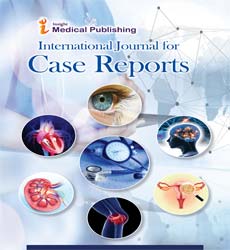Infection with Infuenza B and Kawasaki Disease
Nabiha Zia*
Department of Pathology, Federal University of Minas Gerais, Pakistan
- *Corresponding Author:
- Nabiha Zia
Department of Pathology, Federal University of Minas Gerais, Pakistan
E-mail:A_saoiha@yahoo.com
Received Date: July 13, 2021; Accepted Date: October 18, 2021; Published Date: October 29, 2021
Citation: Zia N (2021) Infection with Influenza B and Kawasaki Disease. J Case Rep Vol.5 No.6
Editorial
Extracutaneous mastocytoma is a benign tumour made up of mature mast cells that develops outside of the skin. We present the case of a 61-year-old man who had colonoscopic polypectomy and biopsy after being diagnosed with extracutaneous mastocytoma. Patients with low back pain and radicular lower extremities discomfort may benefit from caudal epidural injections since they are simple, effective, and safe. Although different issues connected to the surgery's technique or the medications used in the process have been recorded, the Posterior Reversible Encephalopathy Syndrome (PRES) for this intervention has yet to be identified We describe a case of PRES in our patient who suffered convulsions, changes in awareness, and vision loss after receiving caudal epidural steroid, and whose imaging results regressed with the regression of clinical symptoms during the therapy process. Bilateral common iliac vein thrombosis was discovered on contrast tomography of the abdomen and pelvis. An abdominal-pelvic angiography was conducted after eliminating out acute surgical abdomen or immunological diseases, and the diagnosis of May-Thurner syndrome was made. This study looked at a benign cardiac tumour that was discovered by chance on a chest X-ray. A thickwalled left lung cavity occurred following earlier inflammation and concurrent enlargement of the cardiac shadow on radiological scans of a 42-year-old patient with no indications of a heart disease. During the COVID-19 pandemic, an adolescent was diagnosed with Influenza B infection and Kawasaki illness. An asthmatic female adolescent was admitted with acute respiratory failure needing mechanical ventilation after presenting with fever and flu-like symptoms for 7 days. She developed hemodynamic instability that was sensitive to vasoactive medications as she progressed. On chest computed tomography, a massive subepicardial lipoma with a persistent abscess on the left lung was discovered. The treatment included video-assisted thoracoscopic surgery to remove both the lung and heart lesions at the same time. Antibiotic medication and supportive measures were started, which resulted in improved hemodynamics and respiratory function, although with a persistent fever and elevated inflammatory markers. She developed bilateral non-purulent conjunctivitis, hand and foot desquamation, strawberry tongue, and cervical adenopathy during her stay in the hospital, and was diagnosed with Kawasaki disease. She was given intravenous immunoglobulin and, because of her refractory clinical circumstances, corticosteroid therapy; she was afebrile 24 hours later. There were no coronary changes discovered. Only the Influenza B virus was isolated using a comprehensive viral panel that included COVID-19 Creactive protein and serology. She was diagnosed with pulmonary thromboembolism while in the hospital. There could be a link between Kawasaki disease and infection with Influenza B or other viruses like coronavirus. As a result, this link should be evaluated in paediatric patients with persistent febrile illnesses, including teenagers. Diffuse midline glioma with a histone H3 lysine27-to-methionine mutation (H3 K27M mutation) is a rare, aggressive tumour that, regardless of histologic characteristics, is classified as WHO grade IV. Due to a lack of information supporting distinguishing clinical and imaging criteria, preoperative diagnosis remains difficult.
Conclusion
The case of a young woman with communicating hydrocephalus who had gradually worsening headaches is described. Diffuse leptomeningeal enhancement was seen on MR imaging with contrast of the cervical and thoracic spine, with specific areas of intramedullary and subarachnoid T2 hyperintensity and enhancement, suggesting a possible infectious process.
Open Access Journals
- Aquaculture & Veterinary Science
- Chemistry & Chemical Sciences
- Clinical Sciences
- Engineering
- General Science
- Genetics & Molecular Biology
- Health Care & Nursing
- Immunology & Microbiology
- Materials Science
- Mathematics & Physics
- Medical Sciences
- Neurology & Psychiatry
- Oncology & Cancer Science
- Pharmaceutical Sciences
